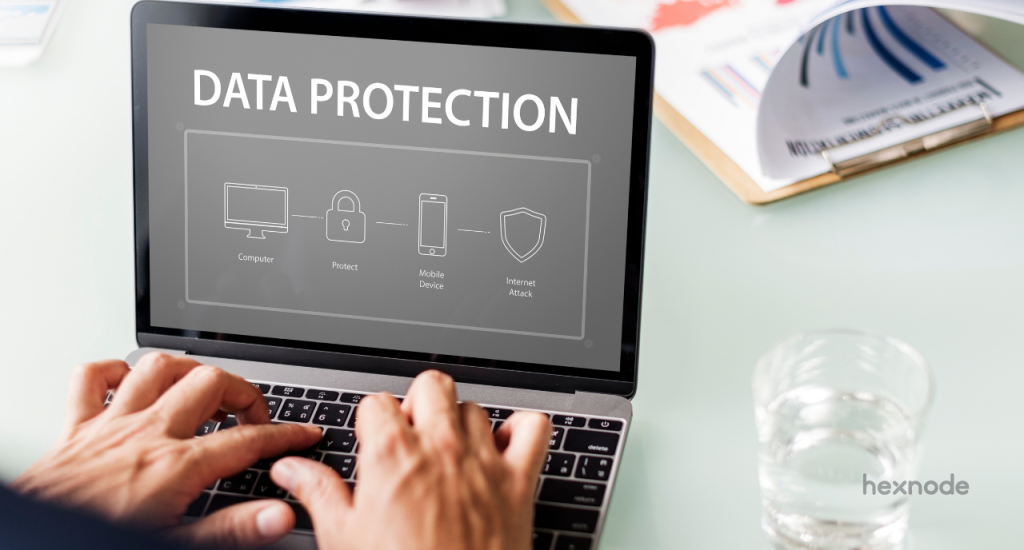Why is access control important for both IT teams and employees?
Access control enforces stringent regulations, establishes limitations, and deters unauthorized entry.

Get fresh insights, pro tips, and thought starters–only the best of posts for you.
Wayne Thompson
Mar 30, 2023
10 min read

In today’s digital age, mobile devices are an integral part of businesses. They help in increasing productivity, improving customer service, and facilitating communication. However, with the rise of such devices, there has been an increase in security threats as well. Therefore, it is essential to implement mobile device security best practices to protect sensitive business data.
The consequences of a security breach can be devastating for a business, ranging from financial losses to loss of reputation. Today, cybercriminals are always looking for vulnerabilities in devices to exploit.
As a result, mobile devices have become an easy target for hackers to access sensitive business data. Hence, device security has become a top priority for businesses. So, it is the business owner’s responsibility to make sure his/her devices are secure. This means taking measures such as updating software, implementing firewalls, and enforcing strong passwords.
One of the simplest and most effective ways to secure mobile devices is by using strong passwords and two-factor authentication (2FA). Passwords and 2FA secures access to devices and data, making it difficult for unauthorized personnel to gain access to sensitive information.
To create a strong password, one should use a combination of upper- and lower-case letters, numbers, and symbols. Moreover, passwords should not be the same for multiple accounts and should be changed frequently. Implementing Identity and Access Management (IAM) can also be beneficial to control access to data. There are different types of 2FA, such as text message verification, push notifications, and hardware tokens. Companies can choose the type of 2FA that suits their business needs.
Keeping mobile apps and software up-to-date is essential to ensure the latest security patches and fixes are installed. It helps prevent hackers from exploiting vulnerabilities in outdated software and applications. Also, users can check for updates manually or set automatic updates to keep their devices secure.
Firewalls are network security devices that help prevent unauthorized access to a network. Implementing firewalls on mobile devices can protect them from network-based threats, such as malware and viruses.
Installing antivirus and anti-malware software is crucial in preventing malicious software from infecting mobile devices. Antivirus software detects and removes viruses, while anti-malware software helps detect and remove malware. There are different types of antiviruses and anti-malware software available in the market, and businesses should choose the one that suits their needs.
A device management solution (MDMs or UEMs) can be an effective step to secure your business data. This type of solution allows you to manage and control the devices that are accessing your business data, which can help to minimize the risk of data breaches and other security incidents. Furthermore, with a device management solution, you can enforce security policies across all the devices that are accessing your business data. This can include policies around password requirements, device encryption, remote wipe capabilities, etc.
Data encryption is a method of securing data-at-rest by converting it into an unreadable format. Thus, implementing data encryption is essential for businesses that deal with sensitive information. There are different types of data encryption, such as symmetric encryption and asymmetric encryption. Users can encrypt data using different software, such as BitLocker and VeraCrypt.
VPNs are a secure way of accessing company networks remotely. VPNs create an encrypted connection between the user’s device and the company’s network, making it difficult for hackers to intercept the data. There are different types of VPNs, such as SSL VPNs, remote access VPNs, IPsec VPNs, etc.
Remote lock and data wipe are crucial features that help prevent data breaches in case of lost or stolen devices. IT administrators can remotely lock or wipe devices to prevent unauthorized access to sensitive business data. Remote lock and data wipe features are available in UEM solutions, and businesses can also use mobile device management software to remotely manage devices.
Regular security audits can help businesses identify vulnerabilities in their mobile devices and take necessary actions to address them. Security audits can be conducted using different tools, such as vulnerability scanners and penetration testing. Businesses should also ensure that their security policies are up-to-date and comply with industry standards and regulations.
Educating employees on mobile device security best practices is essential in preventing data breaches. Furthermore, employees should be trained on how to use mobile devices securely, such as avoiding using public Wi-Fi and not sharing passwords. They should also be educated on the importance of data security and how to report security incidents to the IT department.
UEM solutions provide comprehensive device management, application management, and content management. Furthermore, they also include features that help with data loss prevention, such as password policies, app updates, encryptions, reports, VPN, and remote management.

Managing and maintaining security across hundreds of corporate devices is not an easy task for an IT team. Unified Endpoint Management (UEM) solutions have made the whole device management process simpler for enterprises and the IT admins.
Download the whitepaperA password policy helps in data loss prevention by requiring users to create strong and unique passwords, which are difficult for hackers to guess or crack. This reduces the likelihood of unauthorized access to sensitive data and systems. Furthermore, password policies also enforce regular password changes and prohibit the use of commonly used or easily guessable passwords. UEM solutions enable IT administrators to set the password policies, such as password length and complexity, to prevent unauthorized access to mobile devices.
App updates help in preventing data loss by fixing security vulnerabilities, bugs, and glitches in the app. This reduces the risk of data loss or unauthorized access caused by the exploitation of these vulnerabilities. Furthermore, app updates also improve the app’s functionality and performance, which helps to prevent data loss due to app crashes or errors. Additionally, app updates may include new security features that can further enhance the protection of sensitive data, such as two-factor authentication or encryption. Also, IT administrators can use UEM solutions to manage app updates, ensuring that mobile devices are running the latest software versions and patches.
Encryption helps in securing mobile devices by converting sensitive data into an unreadable format that can only be accessed by authorized users with the appropriate decryption keys. This makes it harder for hackers and unauthorized users to access or steal sensitive data, even if they gain access to the data storage devices or systems where the data is stored. Furthermore, encryption also helps to ensure data confidentiality, integrity, and authenticity by preventing unauthorized modifications or access to the data. UEM solutions provide encryption options to protect sensitive business data stored on mobile devices.
Access control helps in by ensuring that only authorized users can access sensitive data or systems. This is achieved through the implementation of security measures such as passwords, biometric authentication, and user permissions. By limiting access to sensitive data to only those who need it, organizations can reduce the risk of data loss due to human error or malicious intent. Additionally, access control allows organizations to track and monitor user activity, which can help to detect and prevent unauthorized access or data breaches.
Scheduling reports helps in data loss prevention by providing organizations with regular and timely updates on their data activities and potential security issues. So, by automating the generation and delivery of reports, organizations can quickly identify anomalies and potential data loss incidents, such as unusual data access patterns, data exfiltration attempts, or unauthorized system access. This allows organizations to take immediate action to mitigate the risk of data loss and prevent further damage. So, UEM solutions generate reports on device usage, app usage, and security incidents, enabling businesses to monitor and address security threats.
By using a VPN, organizations can prevent data loss caused by hackers and cybercriminals who attempt to intercept or steal sensitive data transmitted over public or unsecured networks. Furthermore, VPNs can also provide secure remote access to corporate networks, allowing employees to work from home or on-the-go without compromising the security of sensitive data. UEM solutions include VPN features that enable secure remote access to company networks.
Remote management helps in data loss prevention by allowing organizations to monitor and manage their IT infrastructure and endpoints from a central location, even when they are located in different geographical locations. This enables organizations to quickly identify and respond to potential data loss incidents, such as malware infections, unauthorized access attempts, or system failures. Furthermore, UEM solutions enable IT administrators to remotely manage and monitor mobile devices, including remote lock and data wipe features.
Securing your devices is not just an option, it’s a necessity. It’s like putting a lock on the front door of your house. Without it, anyone can walk in and take what they want. Same with your corporate devices. They have become an essential part of businesses and securing them is crucial in preventing data breaches and protecting sensitive information. Hence, organizations should adopt the mobile device security best practices discussed above to secure their mobile devices and protect their confidential information from security threats.
Why don't you try out Hexnode UEM to manage your organization's devices and ensure maximum security?
Click to sign up